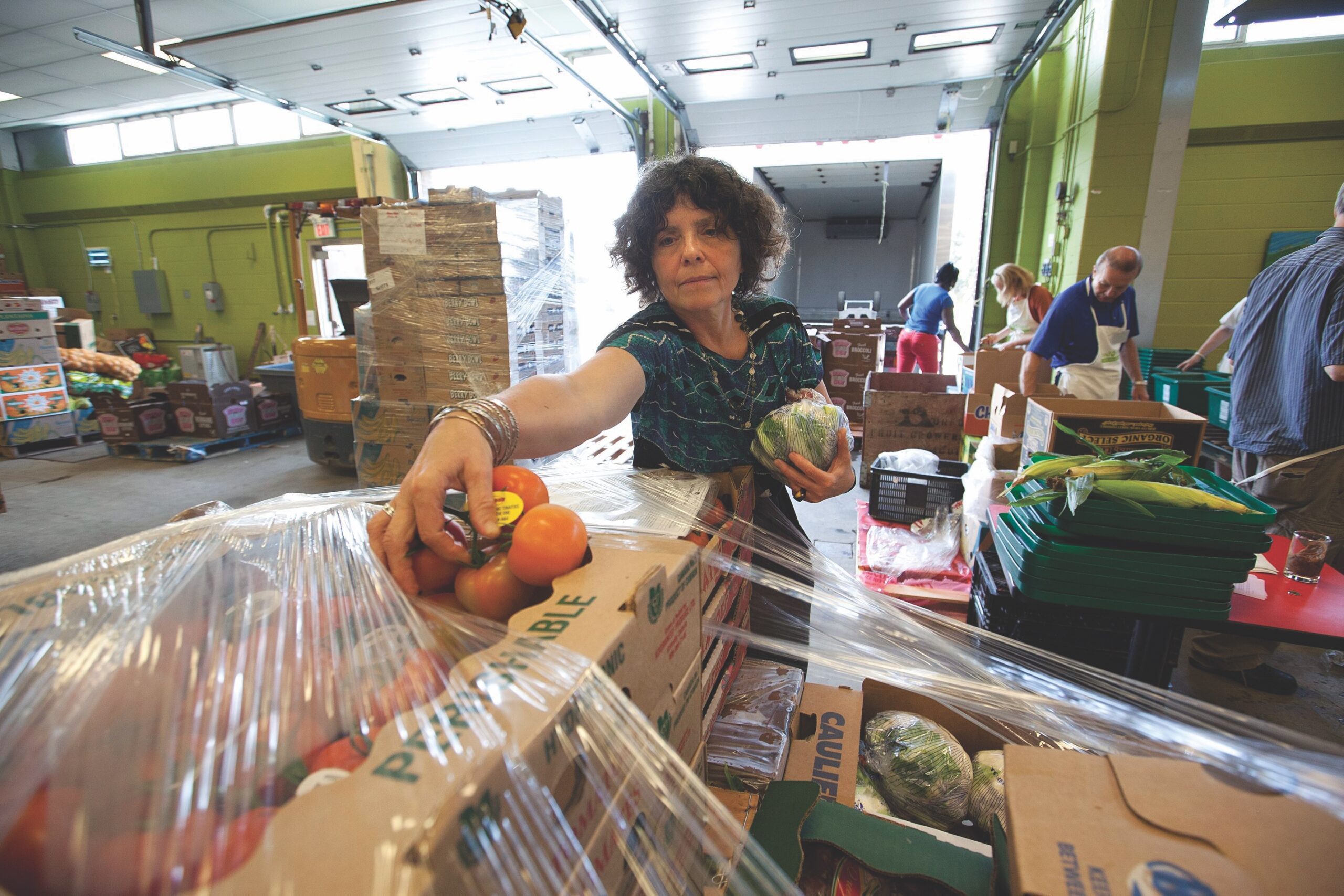One Tuesday this past summer, I spent the morning thinking about the characteristics of a bad apple, and put those conclusions to literal use while sorting fruit. Was a pin-sized bruise acceptable? What about a funny shape? If you were shopping for apples at the grocery store, what would you pick up or put down?
These questions mattered because I was, in a sense, shopping for about 600 other people. Every week, 15 to 20 volunteers gather at the warehouse of a repurposed high school building in west Toronto to sort and pack fresh produce into boxes that are then sold at accessible prices. Run by a local organization called FoodShare, the program delivers nearly 4,000 Good Food Boxes, as they’re called, to homes across the city every month.
Each week’s box brings an assortment of fresh fruits and vegetables sourced as locally as possible, from bunches of kale to bags of Ida Red apples grown in Norfolk, Ont., hand-packed one week by yours truly. The “bad” apples don’t go to waste, either: while a bit too bruised to serve as a snack, they taste just as good in the fantastic apple crumble FoodShare’s kitchen prepares for staff, volunteers and school lunches.
As I quickly learned as a part-time volunteer there, FoodShare is not a food bank. The community non-profit is largely funded through program sales and foundation donations and has a wide range of initiatives addressing food-access issues, from high school gardening programs to community kitchens and nutrition classes.
FoodShare is not alone in this approach. Over the past couple of decades, organizations across Canada have started to address hunger in ways beyond the traditional food bank model. In Calgary, there’s Community Kitchen, which hosts its own Good Food Box program in addition to cooking clubs and elementary school workshops. Vancouver has Fresh Roots, which offers an urban gardening, cooking and market program in secondary schools across the city.
And in Toronto, there’s also Not Far From the Tree, an urban fruit-picking program, and The Stop, a food bank that has reinvented itself as a community food centre.
Common to all of these organizations is a wider philosophy: that long-term hunger can’t be solved with food hampers, that the charity-style model excludes from the process the very people being helped, and that if we’re going to get anywhere in addressing a problem that affects four million Canadians each year, we’re going to have to get political.
The concept of helping people who go hungry may be age-old, but the food bank as an institution is actually a child of the 1960s. John van Hengel, a soup kitchen volunteer from Arizona, is widely considered to have founded the first food bank in North America in 1967.
Canada’s first food bank opened in Edmonton in 1981, a response to the economic recession at the time. Within four years, there were 95 food banks in Canada and, by 1989, a national organization. Today, Food Banks Canada represents about 450 food banks that distributed 9.5 million kilograms of food and other products in 2013 alone; about 350 more exist independently.
Last year, food bank use in Canada was 23 percent higher than it was in pre-recession 2008 and only slightly lower than Food Banks Canada’s record usage numbers in 2012. A little over 830,000 Canadians accessed a food bank each month in 2013, and nearly half of total visits were from people who hadn’t been to a food bank before that year.
“Do we want to get rid of food banks? Absolutely,” says Marzena Gersho, director of communications and national programs at Food Banks Canada. “Food banks on average are giving only three to five days’ worth of food a month. We know that food banks aren’t able to provide that full need because it’s significant.”
In his recent book, The Stop: How the Fight for Good Food Transformed a Community and Inspired a Movement, Toronto-based activist Nick Saul describes what it was like to be a new director at the downtown food bank back in 1998. Working at The Stop had its frustrations: despite a team of dedicated volunteers, there was always a scramble to keep the doors open, never enough food and ongoing conflicts over the ethics of handing out boxes of predetermined items with a beggars-can’t-be-choosers mentality.
Saul describes seeing two women trading hamper items for what they needed most — bananas and canned corn for laundry soap. Another difficult scene unfolded when Saul had to ask a volunteer to stop bringing in leftover produce from local grocers because it was often bruised and wrinkled. “Would you eat this?” he asked. The conversation didn’t end well.
“Food was a pure commodity, the thinking being, ‘We need to get food into people’s bellies,’” Saul says of those times. “We have to think about it not as a commodity. Food is a public good.”
Over the years, Saul introduced programs to The Stop that emphasized participation, giving members opportunities to have a hand in the benefits they received from the organization. First, a community garden began supplementing hampers with fresh, locally grown produce. Then, partnerships with neighbouring non-profits allowed The Stop to connect members with housing and legal services.
With grant money, Saul hired fundraising and support staff to expand the scope of the organization’s programming. Cooking classes, kitchens and a farmers market followed.
Today, The Stop is an internationally recognized two-location centre that employs 40 people, houses an 8,000-square-foot garden and runs a weekly farmers market that sells more than $2 million worth of local food each year. In 2012, Saul left The Stop to found Community Food Centres Canada (CFCC), a national organization that hopes to help non-profits across the country customize The Stop’s community model to their own local needs.
As of this year, the CFCC has successfully partnered with seven organizations in five provinces. Saul hopes to have 15 partnership centres in total open by 2017. “What makes us continue to get up in the morning and come to work is just how the model we discovered and built at The Stop is portable,” says Saul. “It has legs at other places.”
One of those places is Regent Park, a central Toronto neighbourhood that was built as a social housing project in the 1940s and is now being redeveloped into a residential area diverse in both socio-economic and cultural backgrounds. Last fall, the CFCC partnered with the Christian Resource Centre, a United Church outreach now known as the CRC, to expand its local community food centre.
“The neighbourhood is changing into a mixed-income community,” says food centre manager Liz Curran. “In that context, there’s a lot of opportunity to use food to bring the older residents and the newer residents together in that change.” After six months of consulting with Regent Park residents, Curran was able to hire extra staff, break dirt on two new community gardens and expand the CRC’s food skills program.
Some food banks themselves are catching on to the practice of offering more than just food hampers. “Food banks are at the front line and see what’s happening in the economy faster than what some economists might be seeing, but they also need to adapt,” says Gersho. Close to 40 percent of Food Banks Canada’s members, for example, offer skill-based programming.
But neither Gersho nor Saul would describe community food centres or food banks as a cure-all solution to hunger. A cooking class, for example, can teach people how to prepare healthy, inexpensive meals, but it’s not of much use to a single parent whose time is crunched between two jobs, transit and child care.
“It’s imperative that organizations see that private food charity is not an answer,” says Saul. “We have to think about food insecurity and hunger through a political lens.”
Measuring hunger is a tricky business, and food bank numbers tell only part of the story since many people without secure access to food don’t visit food banks.
“What people understand as the problem — absolute deprivation — is simply the thing they’ve been exposed to, which usually comes from ads and appeals for donations,” says Valerie Tarasuk, a nutritional sciences professor at the University of Toronto and one of the country’s top researchers on food insecurity and policy.
Food insecurity, which has only been measured specifically and consistently on the Canadian Community Health Survey since 2005, can mean a sliding scale from worrying about next week’s grocery budget, to buying mostly canned goods instead of pricier milk and vegetables, to skipping meals entirely. All three scenarios are a problem; the latter two have significant health consequences.
Numbers from the 2012 survey suggest that close to four million people in Canada experience food insecurity of some sort, with 1.15 million of that group being under the age of 18. More important, Tarasuk points out, is the fact that more than half of the households that identified as food insecure in 2012 were also in the workforce, but still couldn’t afford to eat well.
“Clearly, our system isn’t working,” says Tarasuk. “I’d like us to call for something else: a national household income.”
While the idea of a guaranteed basic income (that is, topping up salaries that fall below a minimum line) has recently made waves in public policy circles, the examples Tarasuk points to are familiar ones we’re already implementing: Canada’s Old Age Security pension and the Guaranteed Income Supplement. A 2013 University of Calgary study on senior households found that the prevalence of food insecurity for low-income single people dropped by nearly 50 percent between those in their early 60s and those in their late 60s.
“Seniors who rely on a guaranteed household income . . . they are the one group that time and time again surfaces as protected [from food insecurity],” says Tarasuk. “By the time someone turns 65 . . . there are drug benefits, discounted transit fares — the private sector participates actively in benefits to seniors.”
While these programs may not necessarily translate to a retired life of wealth, they do make things comparatively more comfortable. The poverty rate among seniors in Canada is currently 7.2 percent, putting us ahead of many developed countries, including the United States and Switzerland.
During my time as a FoodShare volunteer, I met a woman named Toni Panzuto. Now on staff, she started out as a volunteer with the organization in 1995. Then a single mother who had just graduated from a social work program, she learned that FoodShare needed volunteers for their Hunger Hotline (now called FoodLink), which connected people in emergency hunger situations with programs across the city. It seemed like a perfect fit: the work was in her field of study, and volunteers received a Good Food Box each week.
“My life had taken a turn then — I ended up with two chronic illnesses. I was on ODSP [Ontario Disability Support Program] and had difficulties feeding myself and my son. It was a great opportunity to volunteer somewhere I was interested in, and [the box] definitely supplemented our food bank diet.”
Panzuto has since been involved in a number of FoodShare’s programs and now works as a co-ordinator for the organization’s many volunteers. She understands the need for emergency assistance but isn’t a fan of food banks. She’d love to see minimum wage legislation get passed and is fascinated by some of the solutions working in Brazil, such as publicly funded farmers markets.
“The way out is not going to come [from] any one model,” she says. “It has to come from outside the box.”
Chantal Braganza is a journalist in Toronto.
***
This story first appeared in The United Church Observer’s October 2014 issue with the title “Beyond food banks.”















